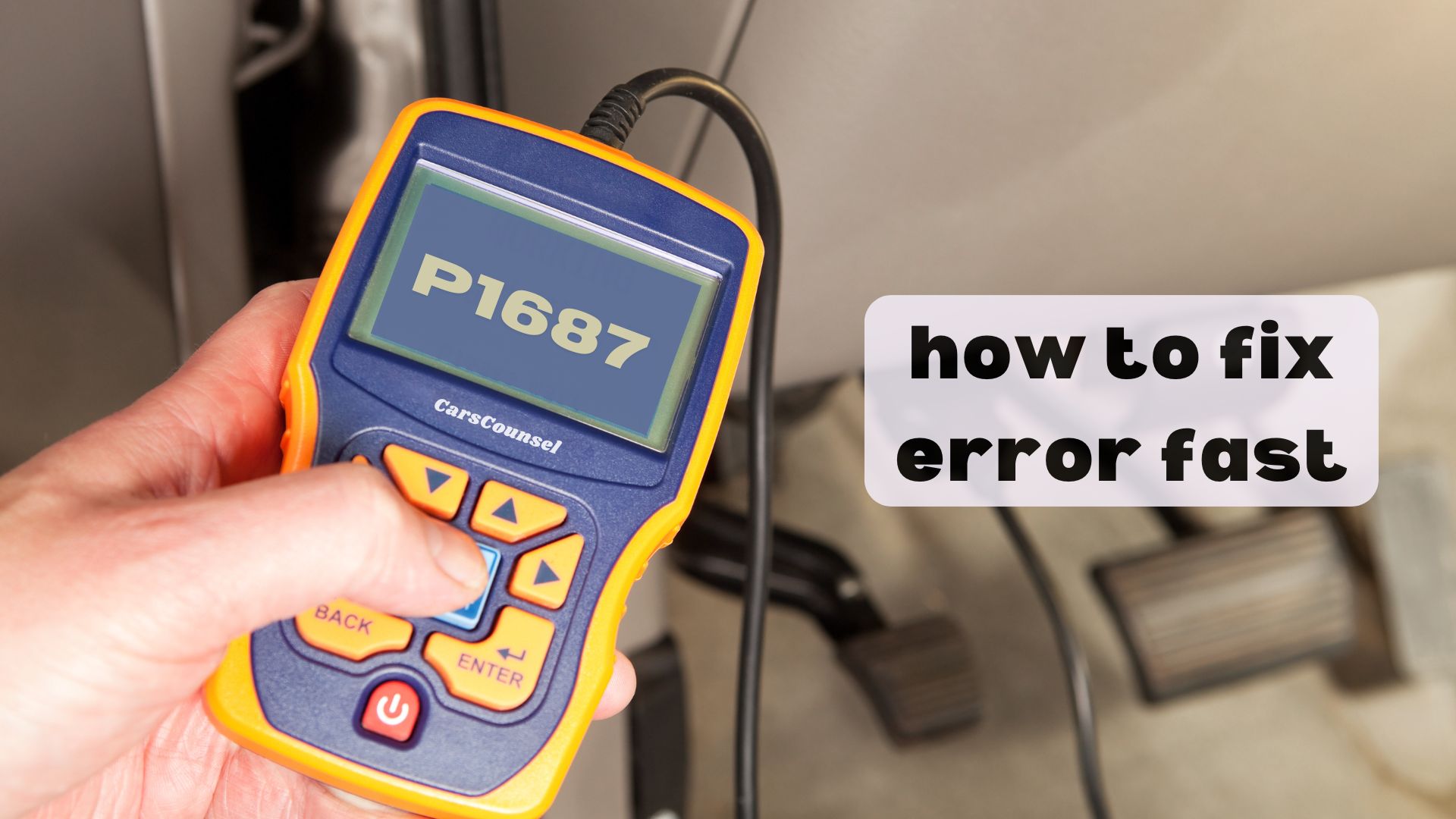You’re not alone if your vehicle’s instrument cluster has suddenly gone haywire – over 10% of modern cars experience cluster bus communication issues. The P1687 code, specifically, indicates a lack of communication on the cluster bus, disrupting the network that connects various modules and sensors to the instrument cluster.
But what’s behind this error code, and how can you get your dashboard back to normal? You’re about to find out the common causes, symptoms, and steps to diagnose and repair this frustrating issue.

Quick Navigation
Key Takeaways
- The P1687 code indicates a lack of communication on the cluster bus, disrupting the network connecting modules and sensors to the instrument cluster.
- Corroded or damaged wiring and connectors in the cluster bus network are common causes of the P1687 code, triggering instrument cluster malfunctions.
- Faulty instrument cluster modules, malfunctioning engine control modules, or software glitches can also cause the code, leading to unsafe driving conditions.
- A thorough wiring inspection, diagnosis, and scan tool analysis are necessary to identify the root cause of the problem and clear trouble codes.
- Repairing or replacing faulty cluster bus components and addressing software glitches can restore normal operation and communication on the cluster bus network.
Understanding Code P1687
When your vehicle’s onboard computer detects a lack of communication on the cluster bus, it triggers the diagnostic trouble code P1687.
This code indicates a disruption in the network that connects various modules and sensors to the instrument cluster.
As a result, you may experience issues affecting your vehicle’s performance and functionality.
The instrument cluster may not display crucial information, such as speed, fuel level, and engine temperature, making it difficult to monitor your vehicle’s status.
This can lead to unsafe driving conditions, emphasizing the importance of addressing the underlying cause promptly.
Common Causes of the P1687 Code
Corroded or damaged wiring and connectors in the cluster bus network are common culprits behind the P1687 code.
You’ll want to inspect the wiring and connectors for signs of damage or corrosion, as this can lead to a Cluster Bus Failure.
A faulty instrument cluster module, malfunctioning engine control module, or software glitches in the vehicle’s computer systems can also trigger the code.
Additionally, water damage or exposure to extreme temperatures can affect the cluster bus components, causing the issue.
A thorough Wiring Inspection and diagnosis are vital to identify the root cause of the problem.
Identifying Symptoms of the P1687 Code
The instrument cluster is your window into the vehicle’s essential signs, and when it malfunctions, you’ll notice it.
Dashboard malfunctions can be frustrating, but they’re often a sign of a more serious issue.
With a P1687 code, you might see erratic or incorrect information on the instrument cluster, or warning lights illuminating without a clear cause.
You might experience loss of communication with other vehicle systems, or your vehicle might go into limp mode with reduced performance.
Cluster failure can make it difficult to monitor your vehicle’s status, leading to unsafe driving conditions.
Be aware of these symptoms to address the issue promptly.
Diagnosis and Troubleshooting Steps
You’ve identified the symptoms of the P1687 code, now it’s time to get to the root of the problem.
Since the code indicates no communication on the cluster bus, you’ll need to inspect the wiring and connectors for signs of damage or corrosion.
Check the instrument cluster module and other related modules for faults using a diagnostic scan tool.
Look for software glitches or water damage affecting the cluster bus components.
Use the scan tool to clear trouble codes and test the vehicle to verify proper communication on the cluster bus network.
Repairing the P1687 Code
Faulty cluster bus components or software glitches are the likely culprits behind the P1687 code.
To repair it, you’ll need to perform a thorough inspection of the cluster bus wiring and connectors for any signs of damage or corrosion.
Check the instrument cluster module and other related modules for faults using a diagnostic scan tool.
Clear the trouble codes from the vehicle’s computer system and test the vehicle to verify proper communication on the cluster bus network.
Cluster repair and bus maintenance are vital to restore normal operation.
Consult your vehicle’s service manual or seek assistance from a professional technician if needed.
Estimated Cost to Fix the P1687 Code
After identifying the root cause of the P1687 code, it’s time to estimate the cost of repairs.
You’ll need to weigh the extent of the damage to the cluster bus network and the complexity of the repair. On average, you can expect to pay between $200 to $500, including parts and labor, for a professional technician to diagnose and fix the issue.
However, diagnosis time and labor rates can vary depending on your location, vehicle make, and engine type. Be sure to research local repair shops and read reviews to find the best rates for cluster bus maintenance.
Additional Resources for Repair
Access to factory service manuals can provide valuable insights and guidance on diagnosing and repairing the P1687 code. You can also consult repair manuals specific to your vehicle’s make and model for detailed instructions and diagrams. Online forums and communities dedicated to your vehicle’s brand or model can be a great resource for troubleshooting and repair advice from experienced owners and mechanics.
| Resource | Description |
|---|---|
| Factory Service Manuals | Detailed repair guides and diagrams specific to your vehicle’s make and model |
| Repair Manuals | General repair guides and instructions for DIY enthusiasts |
| Online Forums | Community-driven troubleshooting and repair advice from experienced owners and mechanics |
| YouTube Tutorials | Video-based repair guides and tutorials from experienced mechanics and DIY enthusiasts |
| Professional Technicians | Expert diagnosis and repair services from trained and certified technicians |
Preventing Future Cluster Bus Issues
Regular maintenance and inspections can help prevent future cluster bus issues, saving you time and money in the long run.
By implementing preventative measures, you can reduce the likelihood of experiencing P1687 code-related problems.
Check your vehicle’s wiring and connectors regularly for signs of damage or corrosion.
Verify all modules, including the instrument cluster and engine control module, are functioning correctly.
Perform software updates as needed, and address any water damage or exposure to extreme temperatures promptly.
More OBD-II Codes
| P1688 | P1689 | P1691 | P1695 |
| P1155 | P1156 | P1157 | P1158 |
| P1159 | P1161 | P1163 | P1164 |
| P1165 | P1170 | P1171 | P1185 |
| P1189 | P1187 | P1190 | P1215 |
| P1216 | P1217 | P1218 | P1219 |
Frequently Asked Questions
Can I Drive My Vehicle With the P1687 Code?
You should avoid driving your vehicle with the P1687 code, as it can lead to poor fuel efficiency, compromised vehicle performance, and even unsafe driving conditions due to lack of critical information on your instrument cluster.
Will a Faulty Instrument Cluster Cause Other Issues?
You’ll likely experience a cascade of issues if your instrument cluster is faulty, as it can trigger instrument faults and cluster failures, affecting other systems like the engine control module, ABS, and more, leading to unpredictable behavior and safety risks.
Can Water Damage Cause the P1687 Code?
You think water damage is just a minor issue, but irony has it, it can be the culprit behind the P1687 code, causing water corrosion and electrical shorts that disrupt the cluster bus communication, leaving you in the dark.
Do All Vehicles Have a Cluster Bus Network?
You’re wondering if all vehicles have a cluster bus network. The answer is yes, most modern vehicles use vehicle networks, such as bus architecture, to connect modules and sensors, enabling communication and data exchange between systems.
Can I Clear the P1687 Code Myself?
Can you diagnose your own car troubles? With a code reader or scan tool, you can try clearing the P1687 code yourself, but be cautious – incorrect diagnosis may lead to further issues; it’s recommended to consult a professional technician for a precise fix.
Conclusion
As you navigate the complex landscape of your vehicle’s systems, the P1687 code serves as a lighthouse warning of a cluster bus breakdown. Like a ship without a rudder, your vehicle is adrift, vulnerable to misdirection and malfunction. Heed the warning, and chart a course for diagnosis and repair. With precision and speed, you’ll steer your vehicle back to safe harbor, where the instruments cluster shines bright, guiding you through the journey ahead.

